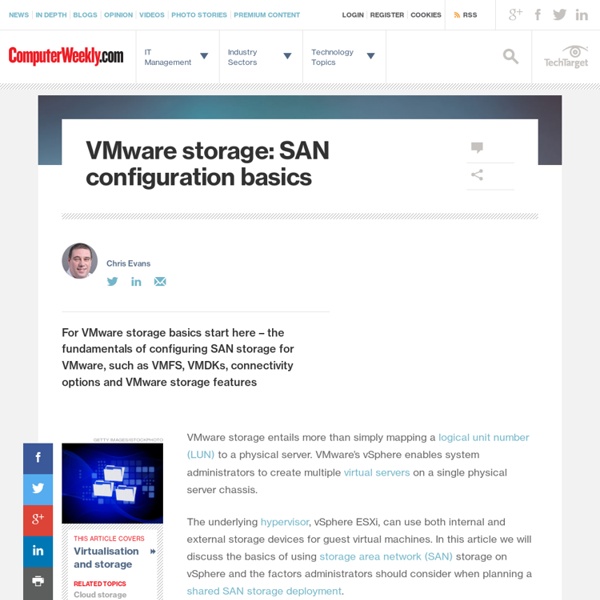VMware storage: SAN configuration basics

VMware Storage and Software-defined Storage (SDS) Solutions Blog Posts
Oregon State University, a public institution with more than 26,000 students and growing VDI workloads wanted a high performance storage tier for their VDI environment. However, they wanted the solution to be up and running before the school summer session began, along with being easy to operate and scale on an on-going basis, without requiring large upfront investments. Continue reading Welcome to the next installment of our vSphere PowerCLI 5.8 walkthrough series of the new cmdlets for vSphere Storage Policy Based Management. Introduction to vSphere Storage Policies Creating vSphere Storage PoliciesAssociating vSphere Storage Policies In this article we will take the next step and illustrate how to leverage vSphere Storage Policies to enhance the provisioning of New VMs. PowerCLI cmdlets referenced in this blog article: New-VM Get-SpbmCompatibleStorage Get-SpbmEntityConfigurationSet-SpbmEntityConfiguration Using the vSphere Web ClientUsing PowerCLI Continue reading Continue reading
VMware vSphere Storage Appliance (VSA) for Shared Storage
End of Availability VMware is announcing the End of Availability of all vSphere Storage Appliance versions, effective April 1, 2014. After this date you will no longer be able to purchase this product. All support and maintenance for vSphere Storage Appliance 5.5 will be unaffected and will continue to follow the Enterprise Infrastructure Support Policy. The End of General Support life date for customers with vSphere Storage Appliance 5.5 remains September 19, 2018. Support contracts can be renewed beyond End of Availbaility until End of General Support. Customers interested in moving to a new VMware software-defined storage solution may elect to upgrade to VMware Virtual SAN.
VMware vSphere Best Practices - VMwaremine - Mine of knowledge about virtualization
VMware tools for nested ESXi If you have nested ESXi running on your homelab environment this is something which you should look at. VMware tools for nested ESXi – very cool flings by VMware labs it does work like on any other guest operating system (Linux, Windows). read more OpenSSL heartbleed bug – VMware products Most probably you are aware about recent finding by The bug was independently discovered by security firm Codenomicon and a Google Security engineer. Sponsor News 04/2014 vCAC 6.0 most annoying installation error During my POC on vCAC I had to struggle with different type of issues but he most annoying one was during IaaS component installation. vCO workflow – change vCPU count Recently I started to develop\build my own vCenter Orchestrator workflows. 2014 top VMware & virtualization blog voting results are out vCAC 6 series – Part 11 – Create Blueprint vSphere 5.5 U1 released with vSAN 1.0 support vCAC 6 series – Part 10 – Prepare for provisioning vSAN 1.0 Announcement
Related:
Related:



